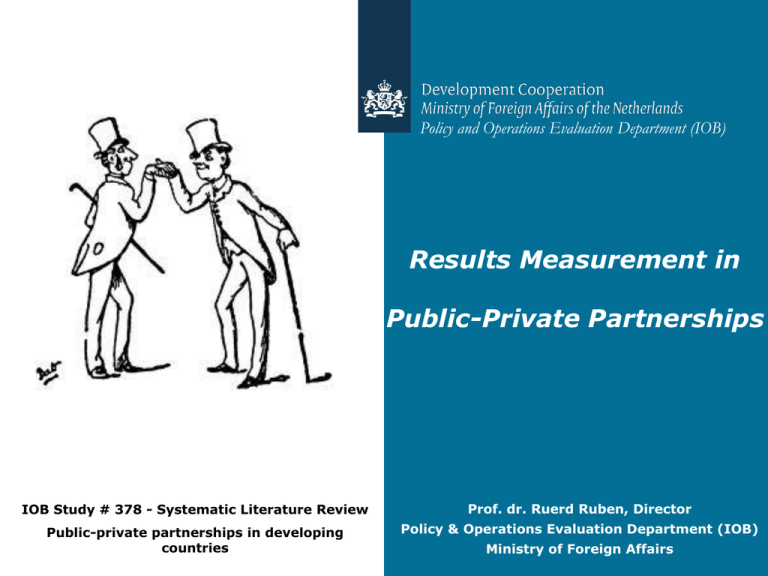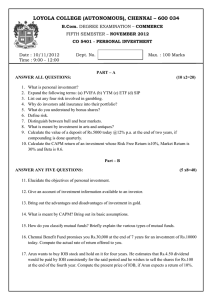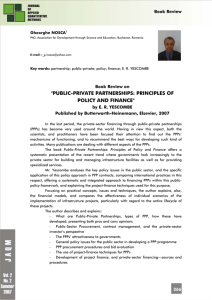Dia 1 - OECD
advertisement

Policy and Operations Evaluation Department (IOB) Results Measurement in Public-Private Partnerships IOB Study # 378 - Systematic Literature Review Prof. dr. Ruerd Ruben, Director Public-private partnerships in developing countries Policy & Operations Evaluation Department (IOB) Ministry of Foreign Affairs Outline of Presentation • Systematic literature review (MSSM levels) • What can be considered to be a Public-Private partnership? • What is the intervention logic of PPP’s? • Which results are registered from PPP’s? • What are critical succes factors of PPP’s? • Conclusion & Outlook 2 Definition of PPPs ‘Form of cooperation between government and business agents – sometimes also involving voluntary organizations (NGOs, trade unions) or knowledge institutes – that agree to work together to reach a common goal or carry out a specific task, while jointly assuming the risks and responsibilities and sharing resources and competences’ Wide variety in contractual terms: ● service contracts, management contracts ● ● ● lease arrangement build–transfer–operate (BTO) and similar arrangements (BOO, DBO, DBGO, DBFMO, etc). joint ventures PPP's in developing countries; IOB study Dutch spending on PPPs (2011) 4 Review approach 1. 2. 3. 4. 5 Keyword search 1433 studies found Title and abstract check + Assesment general characteristics 81 studies Quality check (validity and reliaibilty) 47: 18 cases + 29 reviews Overview (by region & sector) Regional coverage: Asia: Afrika: Latin America: Sectors: Healthcare: Infrastructure: Water: Agriculture: 6 19 (case studies: 10 / reviews: 9) 11 (case studies: 4 / reviews: 7) 4 (case studies: 1 / reviews: 3) 14 7 5 4 Key criteria of PPPs 1. Cooperation between public and private party 2. Clear agreement on goals 3. Combination of private and public funding 4. Agreement on sharing resources and tasks 5. Distribution of risk between partners 7 Character of Developmental PPPs 8 Rationale for PPPs Alternative framwork for dealing with coordination problems, input constraints and output risks Motives: Most important: financial resource mobilization Least important: effectiveness of the partnership (scarce results orientation) PPP's in developing countries; IOB study Results (output & outcome level) Output Outcome 13 7 Mixed - 1 Negative - 1 No effect 2 - No data 3 9 Total 18 18 Positive 10 Critical success factors (1) 1. Permanent government involvement - Set standards and monitor product safety, - efficacy and quality Assure citizens access to products and services 2. Sound regulatory framework - Private partner protected from expropriation, arbitration of disputes Respect for contract agreements and legitimate recovery of costs and profits Based on: Jamili (2004) 11 Critical success factors (2) 3. Formation requirements - 4. Partner selection (4 C’s) - 12 From the very start create clarity about: inputs, committment symetry Common goals, intensive communication, working cultures Compatibilty: complementary strengths Capabilty Commitment Control Critical success factors (3) 5. Common vision and trustfull relationship - Hold-up problem caused by change in the position of partners Cultural differences between partners 6. Interest of key participants negotiated and packaged 13 Traditional ways of working independently have limited impact Long-term interests of partners are balanced Public sector comparator Net savings PPP: $ 9 mln = 7% VfM 14 PPP Transaction costs PPP's in developing countries; IOB study Outlook Are PPP’s a good proposition ? - Yes, can be But: many ‘incomplete contracts’ Only for specific purposes Be aware of critical succes factors – success is not always assured! Evidence on effectiveness & efficiency so far is quite weak PPP's in developing countries; IOB study Thanks for your attention www.iob-evaluatie.nl @IOBevaluatie PPP's in developing countries; IOB study







